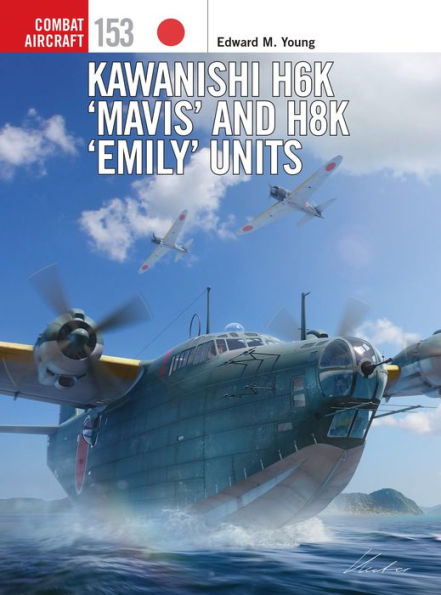An illustrated account of the little-known operations of the Imperial Japanese Naval Air Force's flying boat units during World War 2.
Respectively codenamed the 'Mavis' and 'Emily' by the Allies, Japan's H6K and H8K flying boats outstripped their RAF and US Navy counterparts. The 1941 outbreak of war in the Pacific and Southeast Asia saw these remarkable aircraft carry out offensive missions across vast tracts of ocean and employ their unique capabilities to escort convoys and serve as transports between Japan's island bases. However, while the technical details of the H6K and H8K are well known in the West, this important new study marks the first English-language account of their wartime operations.
Utilizing newly translated Japanese war diaries, as well as Allied intelligence and combat reports, celebrated Pacific War expert Edward M. Young reveals the full story behind the Imperial Japanese Naval Air Force's flying boat units. Contemporary photos and 22 colour profiles bring new dimensions to this fascinating area of Japanese military history, vividly illustrating the pivotal roles of 'Emily' and 'Mavis' in events including the Battle of the Coral Sea, the Battle of Midway and the fighting in the Aleutians and the Bismarck and Solomon Islands.
1143848314
Respectively codenamed the 'Mavis' and 'Emily' by the Allies, Japan's H6K and H8K flying boats outstripped their RAF and US Navy counterparts. The 1941 outbreak of war in the Pacific and Southeast Asia saw these remarkable aircraft carry out offensive missions across vast tracts of ocean and employ their unique capabilities to escort convoys and serve as transports between Japan's island bases. However, while the technical details of the H6K and H8K are well known in the West, this important new study marks the first English-language account of their wartime operations.
Utilizing newly translated Japanese war diaries, as well as Allied intelligence and combat reports, celebrated Pacific War expert Edward M. Young reveals the full story behind the Imperial Japanese Naval Air Force's flying boat units. Contemporary photos and 22 colour profiles bring new dimensions to this fascinating area of Japanese military history, vividly illustrating the pivotal roles of 'Emily' and 'Mavis' in events including the Battle of the Coral Sea, the Battle of Midway and the fighting in the Aleutians and the Bismarck and Solomon Islands.
Kawanishi H6K 'Mavis' and H8K 'Emily' Units
An illustrated account of the little-known operations of the Imperial Japanese Naval Air Force's flying boat units during World War 2.
Respectively codenamed the 'Mavis' and 'Emily' by the Allies, Japan's H6K and H8K flying boats outstripped their RAF and US Navy counterparts. The 1941 outbreak of war in the Pacific and Southeast Asia saw these remarkable aircraft carry out offensive missions across vast tracts of ocean and employ their unique capabilities to escort convoys and serve as transports between Japan's island bases. However, while the technical details of the H6K and H8K are well known in the West, this important new study marks the first English-language account of their wartime operations.
Utilizing newly translated Japanese war diaries, as well as Allied intelligence and combat reports, celebrated Pacific War expert Edward M. Young reveals the full story behind the Imperial Japanese Naval Air Force's flying boat units. Contemporary photos and 22 colour profiles bring new dimensions to this fascinating area of Japanese military history, vividly illustrating the pivotal roles of 'Emily' and 'Mavis' in events including the Battle of the Coral Sea, the Battle of Midway and the fighting in the Aleutians and the Bismarck and Solomon Islands.
Respectively codenamed the 'Mavis' and 'Emily' by the Allies, Japan's H6K and H8K flying boats outstripped their RAF and US Navy counterparts. The 1941 outbreak of war in the Pacific and Southeast Asia saw these remarkable aircraft carry out offensive missions across vast tracts of ocean and employ their unique capabilities to escort convoys and serve as transports between Japan's island bases. However, while the technical details of the H6K and H8K are well known in the West, this important new study marks the first English-language account of their wartime operations.
Utilizing newly translated Japanese war diaries, as well as Allied intelligence and combat reports, celebrated Pacific War expert Edward M. Young reveals the full story behind the Imperial Japanese Naval Air Force's flying boat units. Contemporary photos and 22 colour profiles bring new dimensions to this fascinating area of Japanese military history, vividly illustrating the pivotal roles of 'Emily' and 'Mavis' in events including the Battle of the Coral Sea, the Battle of Midway and the fighting in the Aleutians and the Bismarck and Solomon Islands.
15.49
In Stock
5
1

Kawanishi H6K 'Mavis' and H8K 'Emily' Units
96
Kawanishi H6K 'Mavis' and H8K 'Emily' Units
96eBook
$15.49
$20.00
Save 23%
Current price is $15.49, Original price is $20. You Save 23%.
Related collections and offers
15.49
In Stock

Product Details
| ISBN-13: | 9781472860613 |
|---|---|
| Publisher: | Bloomsbury Publishing |
| Publication date: | 08/15/2024 |
| Series: | Combat Aircraft , #153 |
| Sold by: | Barnes & Noble |
| Format: | eBook |
| Pages: | 96 |
| Sales rank: | 510,633 |
| File size: | 20 MB |
| Note: | This product may take a few minutes to download. |
About the Author
From the B&N Reads Blog
